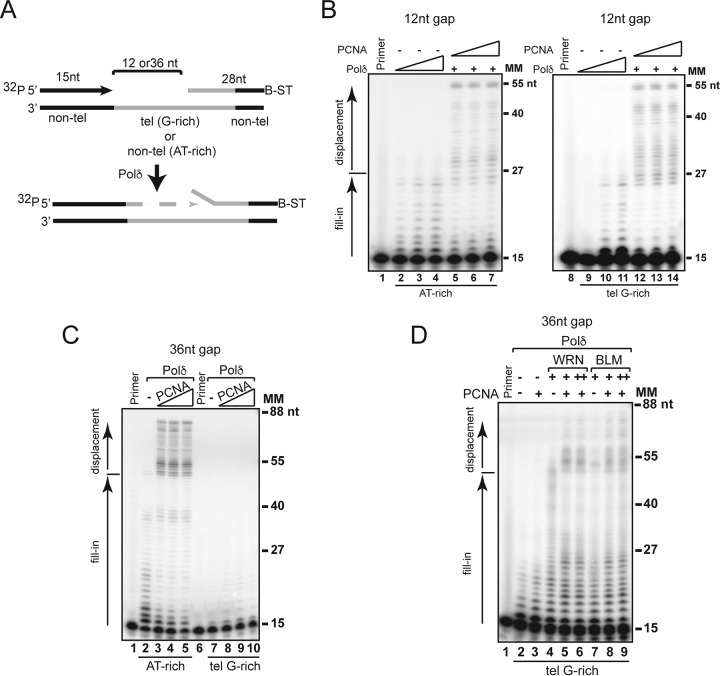FIG 3.
WRN and BLM promote strand displacement synthesis on gapped substrates. (A) Schematic representation of the substrates used to analyze strand displacement synthesis by hPolδ. Nontelomeric sequences were located at the 5′ and 3′ ends of the telomeric template to allow annealing of primer and blocking oligonucleotides, respectively. Primer and blocking fragments were separated by a 12-nt or 36-nt gap. The 3′ end of the blocking oligonucleotide is conjugated with biotin (B) and bound to streptavidin (ST). (B) Purified hPolδ (0.2, 0.4, or 0.8 nM) was incubated with random AT-rich (lanes 2 to 4) or telomeric G-rich (lanes 9 to 11) substrates with a 12-nt gap between the primer and the blocking oligonucleotide under standard conditions. PCNA (5, 10, or 20 nM) and hPolδ (0.2 nM) were added to the reaction mixtures shown in lanes 5 to 7 and 12 to 14. The reactions were terminated after 10 min, and the products were resolved on a denaturing gel and visualized by autoradiography and phosphorimager analysis. The normalized band intensities of the different-length products were generated using PhosphorImager analysis and ImageJ software and plotted as the signal intensity as a function of band migration. Lanes “Primer” contained 32P-labeled primer oligonucleotide only. (C) Purified hPolδ (0.2 nM) in the absence or presence of PCNA (5, 10, or 20 nM) was incubated with random AT-rich nontelomeric (lanes 2 to 5) or telomeric G-rich (lanes 7 to 10) substrates with a 36-nt gap between the primer and the blocking oligonucleotide under standard conditions. The reactions were analyzed as described in the legend to panel B. (D) Purified hPolδ (0.2 nM) in the absence or presence of PCNA (5 nM) (lanes 3, 5 to 6, and 8 to 9), WRN (lanes 4 to 6; 1, 1, and 2 nM, respectively) and BLM (lanes 7 to 9; 1, 1, and 2 nM, respectively) was incubated with a telomeric G-rich substrate with a 36-nt gap between the primer and the blocking oligonucleotide under standard conditions. The reactions were analyzed as described in the legend to panel B. MM, molecular markers. The data shown are representative of the results of at least three independent experiments.

